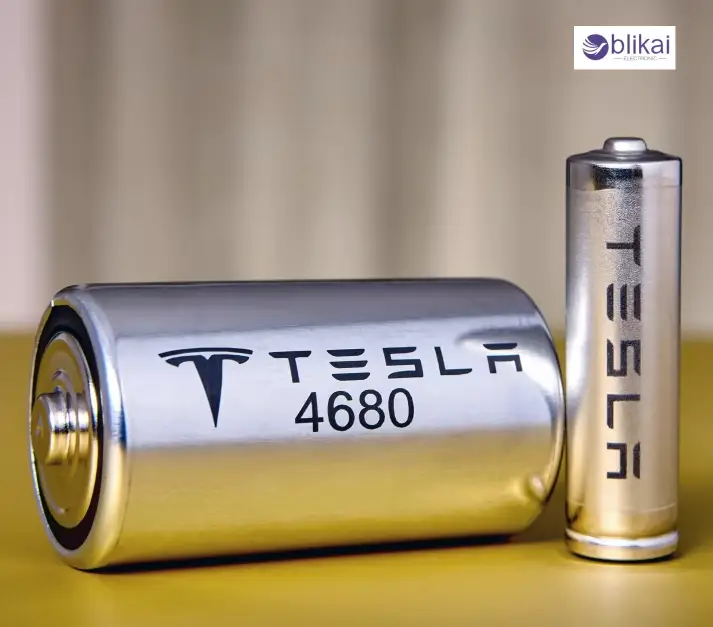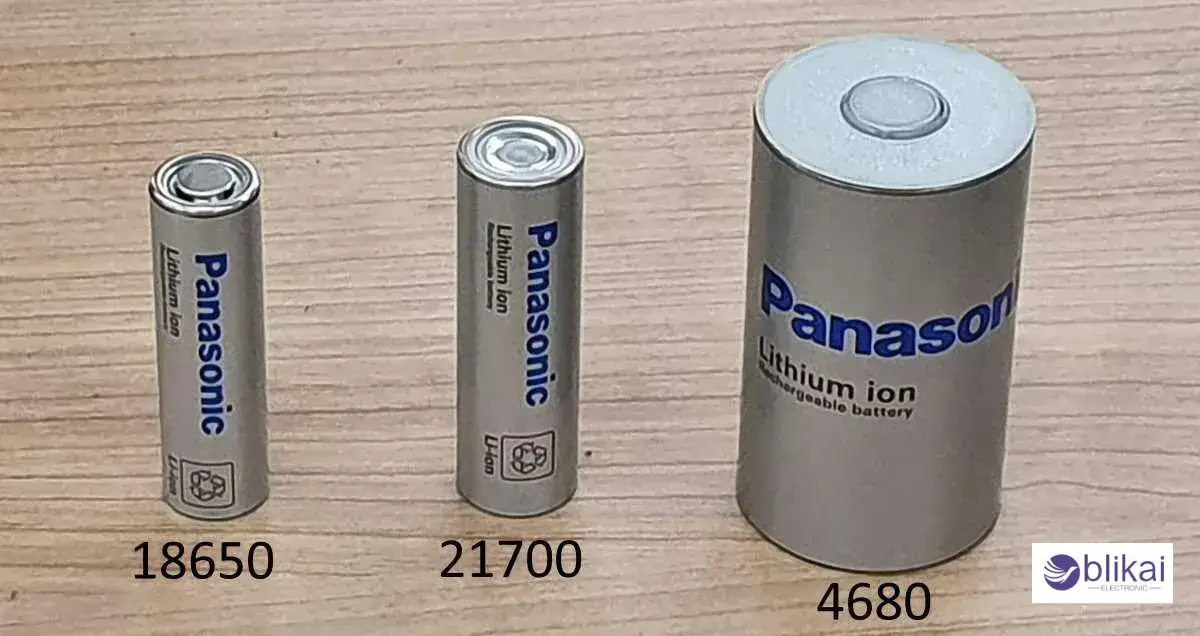4680 Battery Explained: Next-Gen Power Cell
What is a 4680 Battery?
The 4680 battery was proposed by Tesla in 2020 and was designed to address the limitations of the older cell formats, and will be more cost-effective to manufacture. Its trend reflects the rise of higher demand for high-performance batteries in electric cars, energy storage systems and in any other field where efficiency and durability count.
Definition and Explanation of the Name “4680”
The name 4680 is a very descriptive and plain name because it just describes how large the battery is by stating the size. A 4680 battery will, thus, be 46mm in diameter and 80mm high. It is larger than the other standard cells, such as the 2170 (21 mm x 70 mm) cells or the 18650 (18 mm x 65 mm) cells. The size increase is not only in terms of physical size- it is important in increasing capacity, resistance and more importantly, efficiency.
Basic Structure and Specifications
The 4680 battery has the design of a cylindrical cell structure, yet with some major inventions. It has a tableless design, which makes it less resistant internally, thus providing faster charge throughput and thermal management. The bigger cell size offers much more energy-carrying capabilities, and the capacity is estimated to be up to 25-30% greater than older formats. This translates to fewer cells in the entire battery pack, which makes them easier to produce and cheaply.

Why is the 4680 Battery Better?
The 4680 battery is regarded to be better than the earlier lithium-ion designs; the battery has solved many of the limitations of older battery designs and provided overall high gains in efficiency, performance, as well as cost. Its increased size and tablet-like nature make it have better energy density, quicker charging and enhanced thermal management. These characteristics translate to increased driving distances of the electric cars, decreased charge times, and greater life cycles. Moreover, the same capacity can be served by a lesser number of cells, which makes the manufacturing process easier and makes the material more affordable.
Higher Energy Density and Efficiency
The best argument in favor of the 4680 battery is that it has a higher energy density. This enhancement enables a greater amount of energy to be held within a single cell, and therefore, fewer cells are required, and lighter, more efficient battery packs can be made. Also, the tableless architecture minimizes the internal resistance, enabling the flow of electricity to be more efficient. This enhances the rate and energy efficiency of the cell. In the case of electric vehicles, this implies that the range would be extended without dramatically enlarging or enriching the battery pack. In the case of renewable energy usage, it translates to a larger amount of power in a smaller space to store the power and make the most of the energy.
Enhanced Durability and Longevity
The design of the 4680 battery also helps to have better durability and longevity. Better thermal control minimizes heat accumulation, which is among the most common factors of battery deterioration with an aging charge. It enhances the life of the 4680 format in the way that it keeps the cell cooler during the process of charging and heavy use, and this is helpful in saving the life of the product as well as in the performance of the product that still remains the same during the entire life period. This renders it robust, and as such, it doesn’t require a lot of replacements, thus the overall cost paid by the consumers is lowered, as well as the environmental cost incurred in the manufacturing of batteries. The 4680 battery is a more sustainable and viable solution to a broad spectrum of applications in the long run because of these benefits.
Comparison of 4680 Battery with 18650 Battery, 21700 Battery
The applications of the 18650 and 21700 batteries have been extensive in laptops, power tools and the old-time electric cars. Nevertheless, the 4680 battery is much larger, and it comes with new structural innovations such that the energy density, cost-efficiency and ease of production can be maximized. This is the 4680 battery, and such improvements render it as one of the first lithium-ion technology products.

Size and Capacity Differences
The 18650 battery has a size of 18 mm by 65 mm in diameter and length, respectively, compared to the 21700 battery, which has a size of 21 mm by 70 mm in diameter and length, respectively. The 4680 battery sizes are, however, 46mm in diameter and 80mm in length. This large size increase enables the cell of 4680 to hold a large amount of active material, hence high energy capacity. The 4680 battery is able to provide an average of 25-30% higher capacity/cell than the 21700 and far more than the 18650. This implies that it can hold more energy, but not proportional to weight or size, and this has a direct impact on the range of electric vehicles.
Technical Design Differences
The tablet design is one of the most important technical innovations of the 4680 battery that lowers the internal resistance and enhances the efficiency of energy flow, and minimizes the production of heat. However, the 18650 and the 21700 batteries have conventional tab structures, which make them more resistant and restrict their operation with heavy loads. The 4680 has been designed to be tableless, not only to enhance efficiency but also to greatly increase thermal control to allow safer and more consistent operation. Additionally, the 4680 may be produced in a large-scale format, which increases the complexity and cost of manufacturing because of the large size. These changes in the design make it a superior choice for high-demand usage.
Performance and Application Differences
The 4680 battery is highly beneficial in energy density, charging rate, life, and cost-effectiveness as far as its performance is concerned. Although the 18650 and 21700 batteries have proven to be successful products in the world of electric cars and consumer electronics, their shortcomings have become increasingly apparent as the world demands an increased level of performance and range. The 4680 battery also offers a greater driving range, increased charging rates, and fewer cells per battery pack, which makes it easier to assemble. Such advancements do not just make it the perfect choice for the next generation of electric vehicles but also an excellent candidate in terms of large-scale renewable energy storage systems.
Applications of 4680 Batteries
The design enhancements that the 4680 battery offers enable it to be extremely flexible, as its uses include not only electric vehicles but also the storage of renewable energy and more. The fact that it has a high energy density and can be charged quicker, and has a longer life is a response to the crucial needs of the EV industry, where the range, performance, and cost are more important factors. Tesla has already seen automakers installing 4680 batteries in new models of automobiles in order to save on costs and improve efficiency. In addition to car uses, the large-scale energy storage systems using these batteries promise a major future in the automotive sector since they can be used to stabilize the grid by storing surplus energy produced by the renewable sources that can be withdrawn later.
Electric Vehicles
Although they are currently used in ultra-fast electric vehicles, the most notable use of 4680 batteries is in electric vehicles, which are set to reinvent performance and cost-effectiveness. The increase in energy density and accelerated growth of charging make EVs more workable in their daily application, which not only increases the range of driving but also decreases charging time. Less weight and less complexity also mean fewer cells per pack and better vehicle efficiency.
Renewable Energy Storage
In addition to vehicles, there are also considerable opportunities in the storage of renewable energy, which is one of the key factors in the transition to clean energy with a 4680 battery. The production of solar and wind power is intermittent, and therefore, there is a need to have an efficient system of energy storage so that there is a balance between supply and demand. The increased performance and output of the 4680 battery make it suitable to store a lot of energy in a small size. This will enable better use of renewable energy and help to decrease the dependence on fossil fuels. The technology would operate homes, businesses, and even entire communities and contribute towards a quicker shift to a sustainable energy future.
Other Potential Uses
Although the most obvious applications are electric vehicles and renewable energy storage, 4680 batteries might also have other applications in other emerging technologies. As an example, they may be used to drive drones, heavy machinery, electric aviation, and other industrial machine devices where the energy capacity and rapid charge rates are critical. The safety and durability of the battery render it applicable in applications where it is to be used in long working cycles and demanding environments. With continued research and production of the 4680 cell, there are more probable applications of the cell, which will only enhance its position as a disruptive technology in various sectors.
Conclusion
The 4680 battery is a milestone in the history of lithium-ion technology, not only in terms of innovative design but also in tremendous performance gains. The increased size, extended energy density, tableless format, and improved thermal controls overcome several of the drawbacks of the older battery formats. Such innovations turn it into the game-changer of electric cars, energy storage, renewable energy, and numerous other emerging applications. Despite the fact that some issues, such as the quantity of production and the materials supply, are still there, one cannot overlook the possibility of the 4680 battery to transform the transportation and energy infrastructure. As the production increases, and the technology changes, the 4680 battery will be an important factor in making the future clean, efficient and more sustainable.
FAQ
How does the 4680 battery improve electric vehicle performance?
The 4680 battery contains a greater energy density, which offers better charging speed, greater thermal control, and higher driving range in EVs. It also offers shorter charge time and better efficiency, and has a lower production cost.
What makes the 4680 battery different from older formats like 18650 and 21700?
The 4680 battery is bigger; it has a tabless design with increased capacity and lower resistances, quicker charge, better thermal control, and less complicated to manufacture than the 18650 and 21700 cells.
Where can 4680 batteries be used beyond electric vehicles?
In addition to EV, 4680 batteries will be used in the storage of renewable energy, industrial machines, drone usage, electric aviation and other high-demand metrics that require a long cycle life, high capacity and efficient energy storage.
Some images are sourced online. Please contact us for removal if any copyright concerns arise.
NMC Battery vs. LFP Battery: A Detailed Comparison
EFB Battery vs. AGM Battery: Comparing the Differences
Dry Cell Battery vs Wet Cell Battery: Differences
NiCd Battery vs NiMH Battery: Differences
Boat Battery: Types, Chemistry & How to Choose
Battery Isolator Explained: Functions, Types & How to Choose
UPS Battery Guide: Types, Lifespan, Replacement & Safety Tips
2 Gauge Battery Cable: Applications, Features & Comparisons
C Battery vs AA, AAA, D & 9V Battery: Differences
6V Battery vs 12V Battery: Features, Applications & Performance










